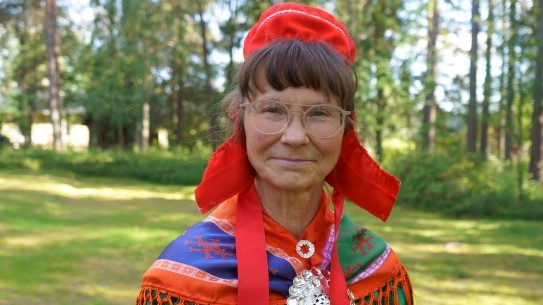Gunnvor Guttorm speaks about "Doudji"

Transcription
Gunvor Guttorm
Duodji is basically a creative Sami activity that springs from Sami life
Narrator
You heard Gunvor Guttorm, professor of Duodji at the college in Kautokeino in northern Norway. She has looked at Britta Marakatt-Labba's art in the context of duodji, the relationship with materials, the process, and reuse. But what is duodji in Sami life...?
Gunvor Guttorm
And what has Sami life been like. It has consisted of survival. So, our forefathers and mothers lived up here in Sápmi and perhaps did not have a lot of material things that they could buy, so it was a very self-sufficient society. And based on that need for self-sufficiency, they became concerned with creating useful items themselves. That is the starting point for Duodji.
Narrator
Then, over the years, it has developed from meeting with other people who have become interested in Sami culture
Gunvor Guttorm
And then began to describe with their own eyes what Sami culture is, and also what Duodji is based on their understanding. And then terms such as folk art, housework, and handicrafts have come to the fore.
Narrator
Gunvor points out that duodji is a Sami term and a Sami activity, but not in a way that it does not have points of contact with other crafts and handicraft activities.
Gunvor Guttorm
That's not how I mean it. It is about the experience that the Sámi and perhaps also other indigenous peoples have in relation to their own cultural expressions, which must come to light much more strongly.
Narrator
Gunvor and Britta have been colleagues and friends for many years. When Britta started studying art, it took some time before she found her form of expression
Gunvor Guttorm
When she found out that she was going to work with embroidery, it suddenly came very naturally to her. Based on that, one can easily read that she uses that experience in working with duodji. And I think that is an experience that she has brought with her from home. So, it is there in the background. After all, she has embodied an experience that has a lot of duojon in it - that is, creating duodji.
After all, she wants to be involved in the process herself, right from the beginning until she has finished the work. She looks at the materials. She dyes them to get the right colours. She finds out what kind of materials she needs.
This thing about reusing, it's what a duojar often does. Instead of throwing it away - and that's what Britta also does - in her works, she finds a way to reuse the materials.